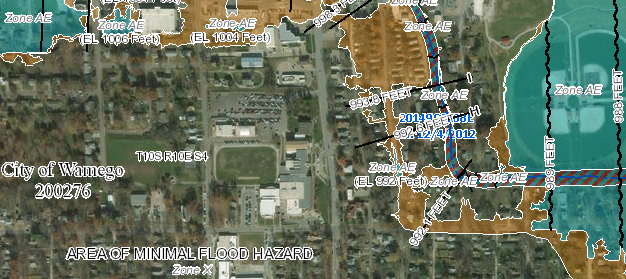If the property you own or plan to own is located near a waterway, creek, river bottom or other low-lying area, it may be in a flood zone. These zones are areas that may have a likelihood of flooding. Did you know that your homeowner’s insurance policy probably won’t cover flood damage? What can you do to protect your property? What will a Lender require if you purchase real estate in a flood zone? Flood zones are also not covered by title insurance. Since there are several flood zones in Riley, Pottawatomie and Wabaunsee Counties, we at Tallgrass Title would like to provide some basic information about them.
-
Who determines where a flood zone is located?
The agency who oversees flood zones is FEMA (Federal Emergency Management Agency). This agency works with a floodplain administrator and community officials to produce maps showing where the risk areas are. Over time, flood zones may change, and new maps are drawn. According to FEMA, a flood zone is a “Special Flood Hazard Area” and is commonly referred to as a 100-year floodplain. This does not mean you can expect a flood once every 100 years. It means that a Special Flood Hazard Area has a one-percent chance of flooding each year.
-
Is the real estate in a flood zone?
If you are purchasing real estate near a waterway or other low-lying area, it is a good idea to check whether the property is in a flood zone. Your realtor can usually assist with this question, but you can also check for yourself at the following link: https://msc.fema.gov/portal.
-
If your real estate is in a flood zone, what will be required?
If you have a lender, they will require flood insurance if the house or structures are in a flood zone. This is a requirement that banks are forced to follow by bank regulations. It is wise to check the coverage of the policy to determine what is actually covered by the insurance. In most conventional residential loans, you will see a “flood zone determination” sheet. Usually, this simply notifies you that the lender checked to see if the real estate is in a flood zone. If the real estate is in a flood zone, there will be some additional paperwork. If you have questions, speak with your lender or real estate agent. The following link will answer a great deal of questions: https://www.fema.gov/national-flood-insurance-program
-
Can my real estate be removed from a flood zone?
In some cases, it is possible to have the structure on your real estate reassessed and removed from the flood zone. There are certain procedures to follow to make that happen. The document that grants the amendment is called a LOMA (Letter of Map Amendment). The application for this document can be downloaded from the FEMA website. Most of the time, a licensed surveyor or other engineer will be required to provide elevations and a site map. FEMA will review the elevation and other data to make the determination. However, this process can take several months to complete. Also, there are no guarantees as to whether the LOMA will be granted.
As you can see, there are questions that often arise with flood zones in real estate transactions. Our closing agents are trained to understand these concerns and answer questions you may have.

